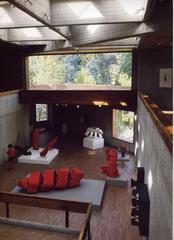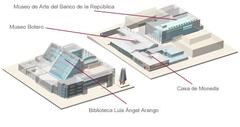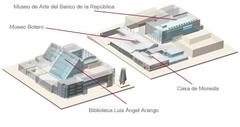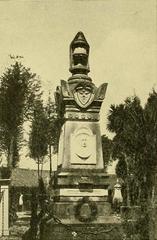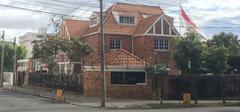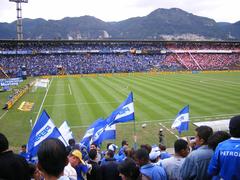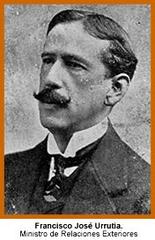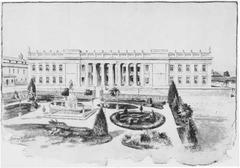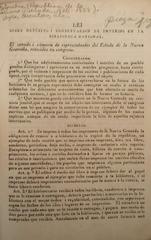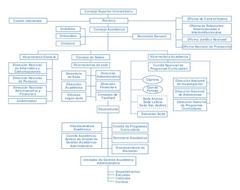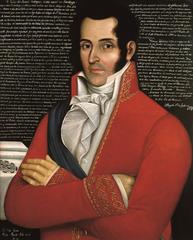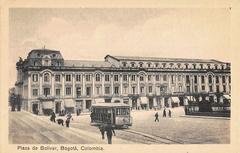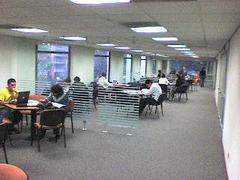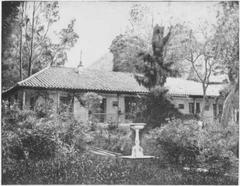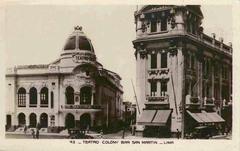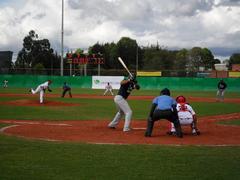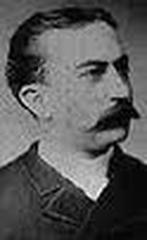
Palace of Justice Bogotá: Visiting Hours, Tickets, and Historical Significance
Date: 03/07/2025
Introduction
Situated on the northern edge of Bogotá’s historic Plaza de Bolívar, the Palace of Justice (Palacio de Justicia Alfonso Reyes Echandía) stands as a powerful symbol of Colombia’s legal authority, the resilience of its institutions, and its turbulent past. This monumental building is home to the country’s highest judicial bodies, including the Supreme Court of Justice, the Constitutional Court, and the Council of State. More than just an operational seat of justice, the Palace is a living memorial to Colombia’s struggles for democracy and the rule of law, marked by dramatic events such as the 1948 Bogotazo riots and the tragic 1985 siege by the M-19 guerrilla group (Backpackers Blueprint; Wikipedia: Palace of Justice siege; Pelecanus; Nomadic Matt).
Today’s Palace of Justice, inaugurated in 1999 and designed by architect Roberto Londoño, fuses modernist style with enhanced security and public amenities. Its sober white stone façade features the enduring inscription of General Santander: “Colombianos, las armas os han dado la independencia, las leyes os darán la libertad” (“Colombians, weapons have given you independence, laws shall give you freedom”). Located among other monumental institutions like the National Capitol and the Cathedral Primada de Colombia, the Palace anchors Colombia’s separation of powers and democratic ideals.
This comprehensive guide explores the Palace’s architectural evolution, major historical events, cultural significance, and practical information for visitors—providing all you need to plan a meaningful visit to this emblematic Bogotá landmark.
Table of Contents
- Architectural Evolution of the Palace of Justice
- Major Historical Events
- Significance in Colombian History and Culture
- Visitor Information
- Frequently Asked Questions (FAQ)
- Nearby Attractions
- Summary & Recommendations
- References
Architectural Evolution of the Palace of Justice
Early Foundations
The Palace of Justice has occupied a prominent place on Bogotá’s Plaza de Bolívar since the early 20th century. The original building, completed in 1921, was neoclassical in style and reflected Colombia’s aspiration for order and republican governance. Its location alongside the National Capitol and the Cathedral Primada reinforced the judiciary’s pivotal role among Colombia’s central institutions (Backpackers Blueprint).
Modernist Rebirth
After the destruction of the first palace during the Bogotazo riots of 1948, a new modernist palace began construction, completed in the late 1960s. Characterized by clean lines, functional design, and reinforced concrete, it symbolized Colombia’s push for modernization and legal stability. Its spacious halls and courtrooms underscored the renewed strength of the judiciary and its accessibility to the public (ArchDaily).
Destruction and the 1985 Siege
The most defining event in the Palace’s history came on November 6–7, 1985, when M-19 guerrillas stormed the building, taking hundreds hostage, including Supreme Court justices. The military’s response, involving heavy fire and a devastating blaze, resulted in the destruction of the building and loss of critical legal archives. Nearly 100 people, including 11 Supreme Court justices, died. This tragedy became a national trauma and a symbol of Colombia’s internal conflict (Wikipedia: Palace of Justice siege; CJA).
Reconstruction and Current Status
The current Palace of Justice, inaugurated in 1999 (with some references citing 2004 for its operational opening), was designed by Roberto Londoño. The new structure retains modernist influences but incorporates advanced security and public spaces. The white stone façade, monumental staircase, and solemn inscription speak to its role as both a seat of justice and a national memorial. Today, the Palace houses the Supreme Court, Constitutional Court, and Council of State (My Global Viewpoint).
Major Historical Events
The 1948 Bogotazo
Triggered by the assassination of political leader Jorge Eliécer Gaitán, the Bogotazo riots resulted in widespread destruction in central Bogotá, including the original Palace of Justice. This event marked the onset of “La Violencia,” a decade-long period of unrest (Reddit: Lost Architecture).
The 1985 Siege
The Palace of Justice siege in 1985 remains one of Colombia’s darkest episodes. The M-19’s takeover was partly motivated by judicial deliberations over extradition treaties. The violent military retaking led not only to significant loss of life but also to unresolved disappearances and ongoing debates about state accountability (CJA; NSArchive).
Rebuilding and Memorialization
After years of investigation and public debate, Colombia rebuilt the Palace as a testimony to institutional resilience. Memorials, plaques, and exhibits inside the building honor the victims and educate visitors about the siege, ensuring that the cost of justice remains in public consciousness (Pelecanus).
Significance in Colombian History and Culture
Symbolism and Public Memory
The Palace of Justice is more than a government building; it is a national symbol of Colombia’s struggle for peace, democracy, and the rule of law. Its repeated destruction and reconstruction mirror Colombia’s efforts to recover from conflict and build a more just society. The building’s location on Plaza de Bolívar places it at the heart of the nation’s identity (Backpackers Blueprint).
Contemporary Role
Today, the Palace is the operational headquarters of Colombia’s highest courts. It is a focal point for civic demonstrations, national commemorations, and public reflection on human rights, transitional justice, and the challenges of post-conflict reconstruction.
International Recognition
The events of the 1985 siege have attracted international attention and have been the subject of legal cases, documentaries, and scholarly research. The Inter-American Court of Human Rights has ruled on abuses associated with the siege, reinforcing the Palace’s role as a symbol in global justice debates (CJA).
Visitor Information
Visiting Hours & Tickets
- Exterior Access: Plaza de Bolívar and the Palace’s exterior are open daily, typically from 6:00 AM to 10:00 PM.
- Interior Access: Entry inside is restricted to official business or special guided tours, usually available weekdays between 9:00 AM and 4:00 PM. There is no general entrance fee, but guided tours require advance booking (Visit Bogotá).
Guided Tours & Accessibility
- Guided Tours: Offered occasionally during commemorative events or through official channels. Advance booking is essential (Nomadic Matt).
- Accessibility: The plaza and exterior ramps are wheelchair accessible. Interior accessibility may vary due to security protocols; inquire ahead for accommodations (Xixerone).
Location & Getting There
- Address: Carrera 8 #10-65, Plaza de Bolívar, La Candelaria, Bogotá.
- Transport: Accessible by foot, taxi, or public transportation (such as TransMilenio). Use reputable taxi apps or hotel-arranged rides for safety (Roads & Kingdoms).
Safety & Travel Tips
- Daytime Visits: Safe with visible police presence; exercise standard urban caution against pickpockets.
- Evenings: The area becomes quieter and less secure after dark; avoid late-night visits (Traveler Bibles).
- Weather: Bogotá’s altitude brings cool temperatures year-round—dress in layers.
- Photography: Allowed outside; interior photography is restricted.
- Amenities: Numerous cafés, restaurants, and public restrooms are available nearby.
Frequently Asked Questions (FAQ)
Q: What are the Palace of Justice’s visiting hours?
A: The exterior and surrounding plaza are accessible daily from early morning to late evening. Interior visits are by appointment or during special guided tours (typically weekdays 9:00 AM–4:00 PM).
Q: Is there an entrance fee?
A: There is no fee for exterior or plaza access; guided tours inside may require advance booking.
Q: Are guided tours available?
A: Occasionally, especially during commemorative events or by official arrangement. Advance booking is necessary.
Q: Is the Palace accessible for people with disabilities?
A: The plaza is mostly accessible. Interior access may be limited; check ahead for specific accommodations.
Q: Is the area safe for visitors?
A: Daytime visits are generally safe with police presence; exercise caution with valuables and avoid the area after dark.
Nearby Attractions
The Palace of Justice is centrally located among Bogotá’s most important historical and cultural sites:
- Cathedral of Bogotá: Colombia’s largest Catholic church, opposite the Palace.
- Capitolio Nacional: Seat of Congress, open for guided tours.
- Museo del Oro: Renowned museum of pre-Hispanic gold artifacts (Nomadic Matt).
- La Candelaria: The historic district with colonial streets, cafés, and museums.
- Museo de Santa Clara: Baroque church-turned-museum (Never Ending Footsteps).
Plaza de Bolívar itself hosts frequent events, protests, and festivities, especially on national holidays (Guided by Destiny).
Summary & Recommendations
The Palace of Justice in Bogotá is a profound testament to Colombia’s pursuit of justice and democracy. Its architectural journey—from the neoclassical first palace destroyed in 1948, through the modernist structure lost in the 1985 siege, to the current monumental building—mirrors the nation’s resilience and challenges. Today, the Palace serves both as an operational seat of high justice and a site of memory, reflection, and civic engagement.
Visitor tips:
- Explore the exterior and memorials anytime.
- Book guided tours in advance for interior access.
- Combine your visit with nearby historical sites for a comprehensive Bogotá experience.
- Always remain respectful of ongoing legal proceedings and the building’s memorial function.
Whether you are a traveler, history enthusiast, or student of law, the Palace of Justice offers invaluable lessons in resilience, human rights, and the enduring power of collective memory (CJA; My Global Viewpoint; Nomadic Matt).
References
- Backpackers Blueprint
- Wikipedia: Palace of Justice siege
- Pelecanus
- ArchDaily
- My Global Viewpoint
- CJA
- Nomadic Matt
- Lonely Planet
- Guided by Destiny
- Xixerone
- Traveler Bibles
- Roads & Kingdoms
- NSArchive
- Never Ending Footsteps
Experience the Palace of Justice as a landmark of resilience, memorialization, and Colombian heritage. For up-to-date information on tours and events, consult the official Palace of Justice website or the Bogotá tourism portal.
Download the Audiala app for guided audio tours and real-time updates on Bogotá’s historical sites. Share your experience with #VisitBogotaJustice and join the conversation about Colombia’s journey toward justice.




